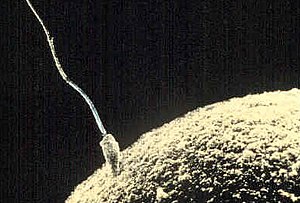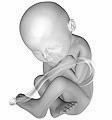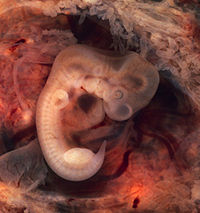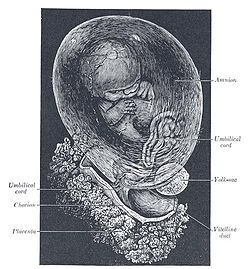This is an old revision of this page, as edited by 3dpregnancy (talk | contribs) at 11:59, 31 August 2007 (Added Prenantal Development Images). The present address (URL) is a permanent link to this revision, which may differ significantly from the current revision.
Revision as of 11:59, 31 August 2007 by 3dpregnancy (talk | contribs) (Added Prenantal Development Images)(diff) ← Previous revision | Latest revision (diff) | Newer revision → (diff) This article is about prenatal development in humans. For other mammals, see mammalian embryogenesis. For a timeline of prenatal development, see Timeline of prenatal development.Prenatal development is the process in which an embryo or fetus (or foetus) gestates during pregnancy, from fertilization until birth. Often, the terms fetal development, foetal development, or embryology are used in a similar sense.
After fertilization the embryogenesis starts. In humans, when embryogenesis finishes, by the end of the 10th week of gestational age, the precursors of all the major organs of the body have been created. Therefore, the following period, the fetal period, is described both topically on one hand, i.e. by organ, and strictly chronologically on the other, by a list of major occurrences by weeks of gestational age.
Fertilization
Main article: Fertilization
When semen is deposited in the vagina, the spermatozoa travel through the cervix and body of the uterus and into the Fallopian tubes. Fertilization of the ovum (egg cell) usually takes place in the Fallopian tube. Many sperm must cooperate to penetrate the thick protective shell-like barrier that surrounds the ovum. The first sperm that penetrates fully into the egg donates its genetic material (DNA). The resulting combination is called a zygote. The term "conception" refers variably to either fertilization or to formation of the conceptus after uterine implantation, and this terminology is controversial.
Like every cell in the body, the zygote contains all of the genetic information unique to an individual. Half of the genetic information residing in the zygote's nucleus comes from the mother's egg nucleus, and the other half from the nucleus of a single sperm. However, the mitochondrial genetic information of the zygote is in its totality contributed by the mother's egg.
Embryogenesis
Main article: Human embryogenesisThe embryonic period in humans begins at fertilization (2nd week of gestation) and continues until the end of the 10th week of gestation (8th week of development).
The zygote spends the next few days traveling down the Fallopian tube. Meanwhile it divides several times to form a ball of cells called a morula. Further cellular division is accompanied by the formation of a small cavity between the cells. This stage is called a blastocyst. Up to this point there is no growth in the overall size of the embryo, so each division produces successively smaller cells.
The blastocyst reaches the uterus at roughly the fifth day after fertilization. It is here that lysis of the zona pellucida, a glycoprotein shell, occurs. This is required so that the trophectoderm cells of the blastocyst can come into contact with the luminal epithelial cells of the endometrium. (Contrast this with zona hatching, an event that occurs in vitro by a different mechanism, but with a similar result). It then adheres to the uterine lining and becomes embedded in the endometrial cell layer. This process is also called implantation. In most successful pregnancies, the conceptus implants 8 to 10 days after ovulation (Wilcox et al 1999). The inner cell mass forms the embryo, while the outer cell layers form the membranes and placenta. Together, the embryo and its membranes are referred to as a conceptus, or the "products of conception".
Rapid growth occurs and the embryo's main external features begin to take form. This process is called differentiation, which produces the varied cell types (such as blood cells, kidney cells, and nerve cells). A spontaneous abortion, or miscarriage, in the first trimester of pregnancy is usually due to major genetic mistakes or abnormalities in the developing embryo. During this critical period (most of the first trimester), the developing embryo is also susceptible to toxic exposures, such as:
- Alcohol, certain drugs, and other toxins that cause birth defects, such as Fetal alcohol syndrome
- Infection (such as rubella or cytomegalovirus)
- Radiation from x-rays or radiation therapy
- Nutritional deficiencies such as lack of folate which contributes to spina bifida
Generally, if a structure pre-dates another structure in evolutionary terms, then it often appears earlier than the other in an embryo; this general observation is sometimes summarized by the phrase "ontogeny recapitulates phylogeny." For example, the backbone is a common structure among all vertebrates such as fish, reptiles and mammals, and the backbone also appears as one of the earliest structures laid out in all vertebrate embryos. The cerebrum in humans, which is the most sophisticated part of the brain, develops last. The concept of recapitulation is not absolute, but it is recognized as being partly applicable to development of the human embryo.
By changes by weeks of gestational age
This section only deals with some major changes in the embryonic period. For the whole list, covering more details and spanning the whole prenatal development, see Timeline of prenatal development
-
 Embryo at 4 weeks after fertilization
Embryo at 4 weeks after fertilization
-
 Fetus at 8 weeks after fertilization
Fetus at 8 weeks after fertilization
-
 Fetus at 18 weeks after fertilization
Fetus at 18 weeks after fertilization
-
 Fetus at 38 weeks after fertilization
Fetus at 38 weeks after fertilization

- Week 2 (week of fertilization)
- Fertilization occurs
- The blastocyst implants onto the mother's uterus.
- Week 3
- Formation of the yolk sac.
- Week 4
- Future spinal cord forms
- Primitive heart tube is forming.
- Week 5
- The heart begins to beat
- The neural tube closes.
- The first traits of the ears, lungs, liver, mouth, gallbladder, pancreas, rectum, splean appear.
- Week 6
- The brain divides.
- Rudimentary blood moves through primitive vessels.
- Week 8
- All essential organs have at least begun formation.
Fetal period
See also: FetusThe fetal period begins at the end of the 10th week of gestation (8th week of development). Since the precursors of all the major organs are created by this time, the fetal period is described both by organ and by a list of changes by weeks of gestational age.
Because the precursors of the organs are formed, fetus also is not as sensitive to damage from environmental exposures as the embryo. Instead, toxic exposures often cause physiological abnormalities or minor congenital malformation.
By organ
Each organ has its own development.
- Development of circulatory system
- Development of digestive system
- Development of endocrine system
- Development of integumentary system
- Development of lymphatic system
- Development of muscular system
- Development of nervous system
- Development of the urinary and reproductive system
- Development of respiratory system
By changes by weeks of gestational age
This section only deals with some major changes in the fetal period. For the whole list, covering more details and spanning the whole prenatal development, see Timeline of prenatal development

- Week 9
- the eyelids are more developed.
- the external features of the ear begin to take their final shape.
- Weeks 10 to 13
- Weeks 14 to 17
- More muscle tissue and bones have developed, and the bones become harder.
- The fetus makes active movements.
- Week 20
- "Quickening" usually occurs (the mother can feel the fetus moving).
- The fetal heartbeat can be heard with a stethoscope.
- Week 24
- The fetus has a hand and startle reflex.
- Footprints and fingerprints continue forming.
- Week 28
- The brain develops rapidly.
- The eyelids open and close.
- The respiratory system, while immature, has developed to the point where gas exchange is possible.
- Weeks 32
- The amount of body fat rapidly increases.
- Bones are fully developed, but are still soft and pliable.
- Week 36
- Fingernails reach the end of the fingertips.
- Weeks 37 to 40
- Small breast buds are present on both sexes.
- Head hair is now coarse and thickest.
References
- ^ Stephen Jay Gould,. Ontogeny and Phylogeny. Cambridge, Mass: Belknap Press. p. 206. ISBN 0-674-63941-3.
{{cite book}}: CS1 maint: extra punctuation (link) - 3D Pregnancy (Image from gestational age of 6 weeks). Retrieved 2007-08-28. A rotatable 3D version of this photo is available here, and a drawing is available here.
- 3D Pregnancy (Image from gestational age of 10 weeks). Retrieved 2007-08-28. A rotatable 3D version of this photo is available here, and a drawing is available here.
- 3D Pregnancy (Image from gestational age of 20 weeks). Retrieved 2007-08-28. A rotatable 3D version of this photo is available here, and a drawing is available here.
- 3D Pregnancy (Image from gestational age of 40 weeks). Retrieved 2007-08-28. A rotatable 3D version of this photo is available here, and a drawing is available here.
- ^ Cite error: The named reference
larsenwas invoked but never defined (see the help page).
- "MedlinePlus Medical Encyclopedia"
- Moore, Keith L. The Developing Human: 3rd Edition. W.B. Saunders Company, Philadelphia PA
- Wilcox AJ, Baird DD, Weinberg CR. Time of implantation of the conceptus and loss of pregnancy. 1999 N Engl J Med. 340(23):1796-9. PMID 10362823
- Ljunger, E, Cnattingius, S, Lundin, C, & Annerén, G. 2005 Chromosomal anomalies in first-trimester miscarriages. Acta Obstetricia et Gynecologica Scandinavica 84(11):1103-1107. PMID 10362823
External links
- Fetal Development Timeline from AboutKidsHealth.ca
- The Changes in Each Stage of Human Development
- Real Time Presentation of Human Embryo Development
| Human embryonic development in the first three weeks | |||||||||
|---|---|---|---|---|---|---|---|---|---|
| Week 1 | |||||||||
| Week 2 (Bilaminar) | |||||||||
| Week 3 (Trilaminar) |
| ||||||||
| Development of the circulatory system | |||||||||
|---|---|---|---|---|---|---|---|---|---|
| Heart |
| ||||||||
| Vessels |
| ||||||||
| Extraembryonic hemangiogenesis | |||||||||
| Fetal circulation | |||||||||
| Development of the digestive system | |
|---|---|
| Foregut | |
| Midgut | |
| Hindgut | |
| Development of the nervous system | |||||||
|---|---|---|---|---|---|---|---|
| Neurogenesis |
| ||||||
| Eye | |||||||
| Ear | |||||||
| Development of the reproductive system | |
|---|---|
| Precursors | |
| Internal | |
| External | |
| See also | |